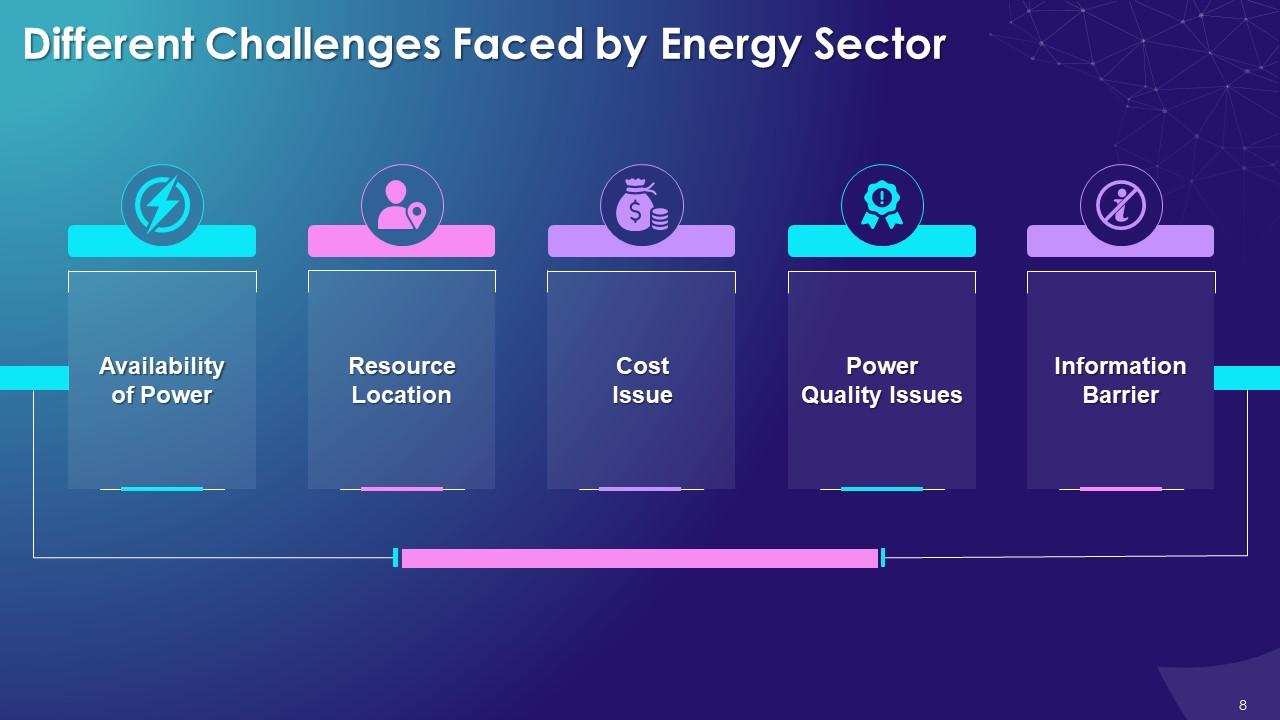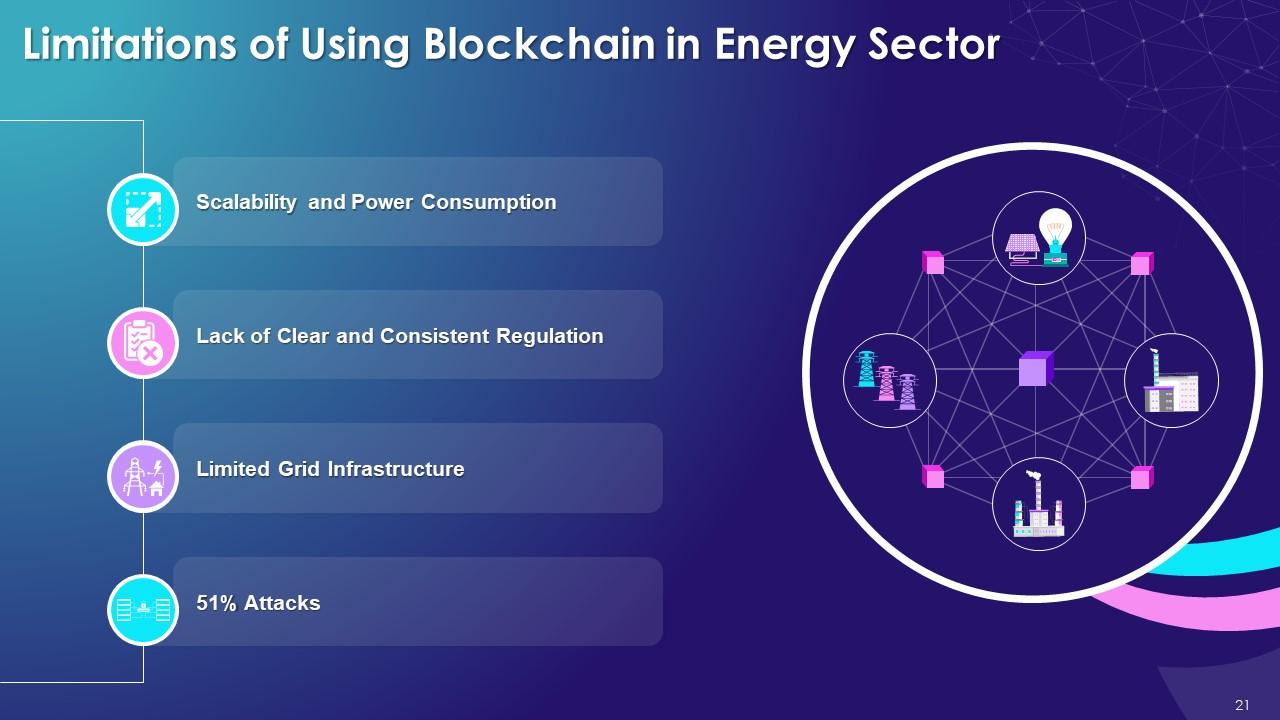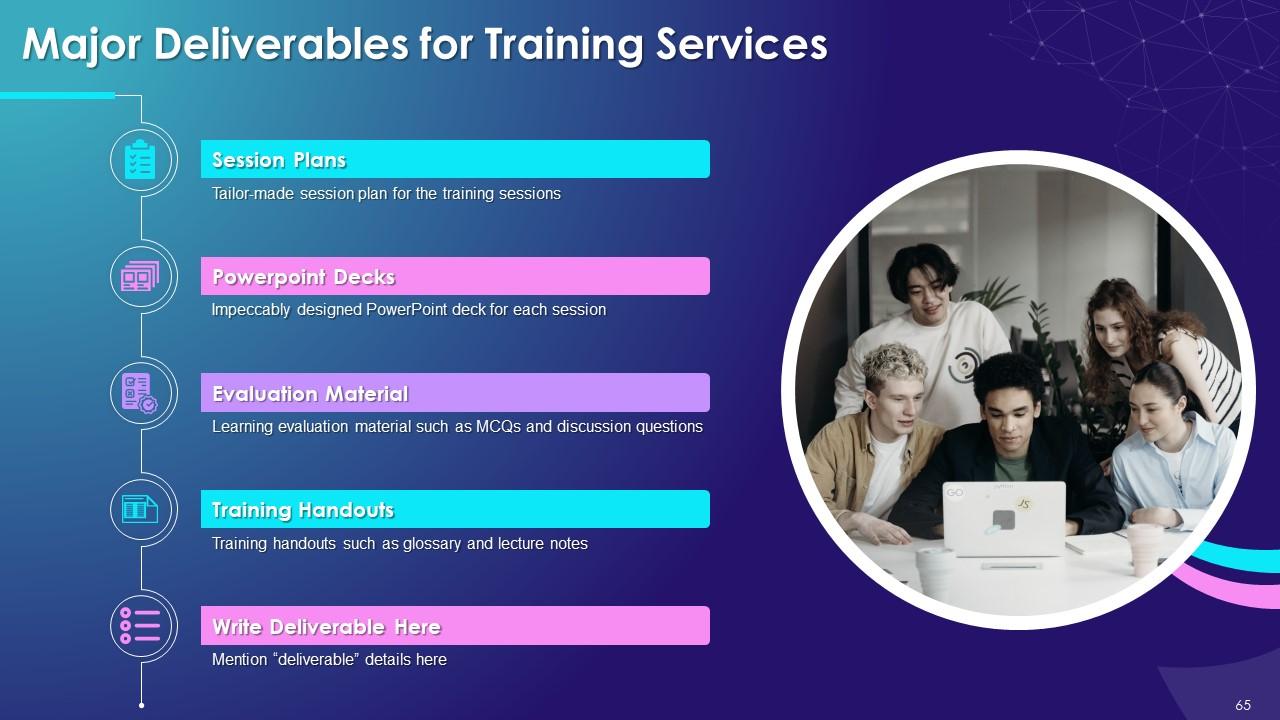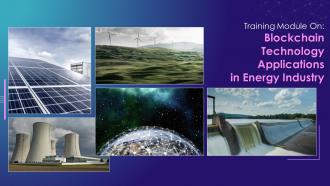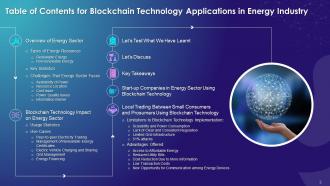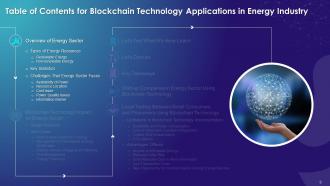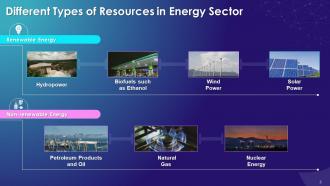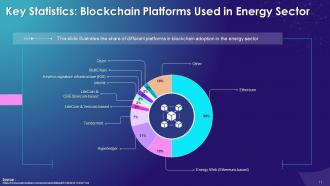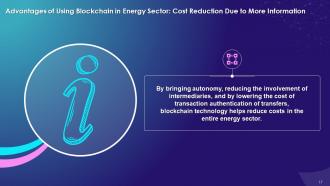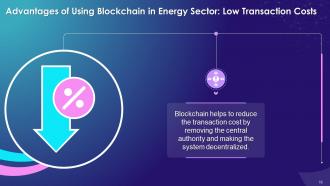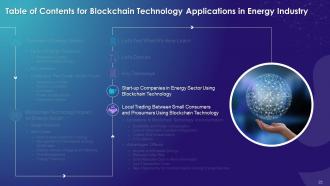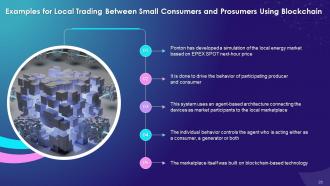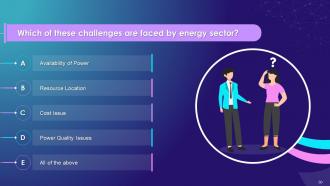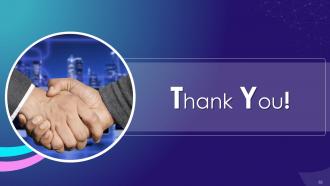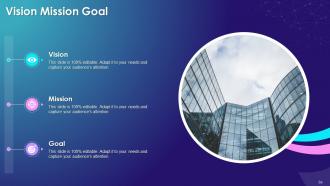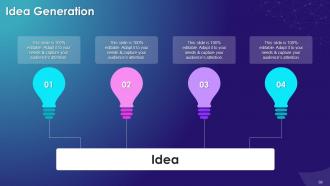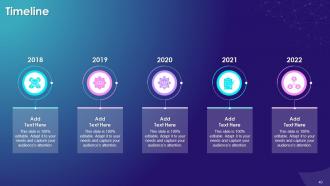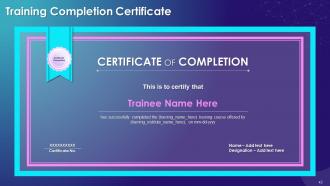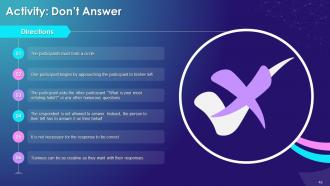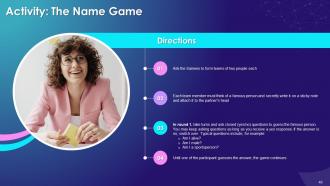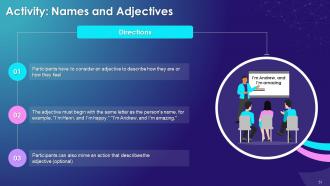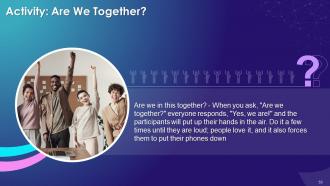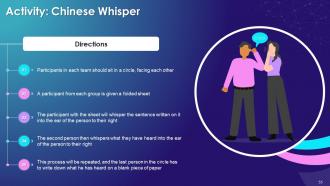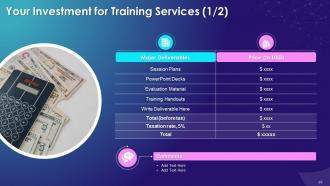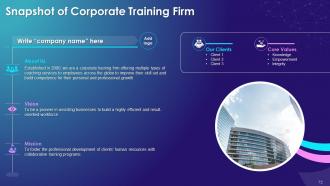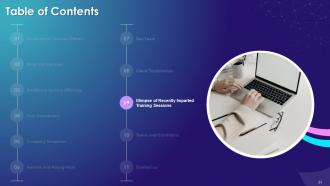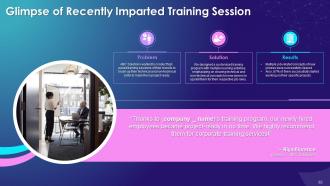Blockchain Technology Applications in Energy Industry Training Ppt
This PPT training deck covers blockchain technology applications in the energy industry. It includes an overview of the energy sector covering types of energy resources renewable energy and non-renewable energy along with major challenges faced by the sector. It also covers the impact of blockchain on the energy sector in terms of use cases such as peer-to-peer electricity trading, management of renewable energy certificates, electric vehicle charging and sharing, grid management, and energy financing. Further, it contains PowerPoint slides on local trading between small consumers and prosumers using blockchain technology. The PowerPoint module also has key takeaways, discussion questions, and MCQs related to the topic to make the training session interactive. It also includes additional slides on about us, vision, mission, goal, 30-60-90 days plan, timeline, roadmap, training completion certificate, energizer activities, detailed client proposal, and training assessment form.
You must be logged in to download this presentation.
 Impress your
Impress your audience
Editable
of Time
PowerPoint presentation slides
Presenting Training Session on Blockchain Technology Applications in Energy Industry. This deck contains 89 plus uniquely designed slides. Our PowerPoint experts have included all the necessary templates, designs, icons, graphs and other essential material. This deck is well crafted by extensive research. Slides consists of amazing visuals and appropriate content. These PPT slides can be instantly downloaded with just a click. Compatible with all screen types and monitors. Supports Google Slides. Premium Customer Support available. Suitable for use by managers, employees and organizations. These slides are easily customizable. You can edit the color, text, icon and font size to suit your requirement.
People who downloaded this PowerPoint presentation also viewed the following :
Content of this Powerpoint Presentation
Slide 4
This slide highlights the meaning of energy sector. It explains that it is set of organizations which are into producing or delivering energy, and it also includes companies that are involved in the exploration and development of oil and natural gas reserves.
Slide 5
This slide illustrates types of energy resources such as renewable and non-renewable. Renewable energy resources include hydropower, biofuels such as ethanol, wind, and solar power. Non-renewable resources of energy include petroleum products and oil, natural gas, and nuclear energy.
Slide 6
This slide illustrates statistics on distributed use of different energy resources for electricity planned in the US. It showcases the percentage use of different energies such as solar energy, wind power, natural gas, batteries, nuclear energy etc.
Slide 7
This slide illustrates statistics on energy consumption of the US by fuel source. It showcases different sources of energy in the US, such as petroleum and other liquids, natural gas, non-hydro renewables, nuclear, coal, hydro, and liquid biofuels. The graph is divided into two sections one is the history of energy consumption till 2021 The other side shows the projection of energy consumption till 2050.
Slide 8
This slide highlights different challenges faced by energy sector such as availability of power, resource location, cost issue, power quality issues, and information barriers.
Instructor’s Notes:
The multiple challenges faced by energy sector are as follows:
Availability of Power:
- The biggest concern is power generation due to dependence on natural resources that humans have not control over
- For Example:
- Solar Energy depends on sunlight to generate power
- Wind Energy depends on the availability of high-speed wind
- The supply of oil and natural gas can get disrupted, again, due to factors that humans cannot predict or control
- Uncertainty in the production of energy is making integration more complex
Resource Location:
- The setting up of energy systems requires large spaces; this is a major hurdle for users to overcome
- Sometimes, the availability of such resources is scarce
- The distance between the energy resource and power grid is also a major issue in terms of cost and efficiency
Cost Issue:
- High upfront installation cost is a major issue in the development of energy systems
- Also, the storage system of generated energy is expensive and represents a real challenge
Power Quality Issues:
- To ensure the stability and high efficiency of the network, high quality power is needed
- The good quality of power supply helps the system work with high reliability and lower cost
- If power quality is not good then it can lead to high cost and equipment failure
- It can also lead to frequency mismatch, voltage variation, low power factor, and transmission lines transits
Information Barrier:
- Renewable Energy sector has considerably evolved over past 5 years, but there is still not widespread awareness about the same
- Government agencies need to assist and advise applicants on how to apply for renewable energy incentives
Slide 10
This slide illustrates the statistics on blockchain activities in energy sector. It showcases the percentage use of different blockchain activities used in energy sector.
Slide 11
This slide showcases the statistics on using blockchain platform in energy sector. It showcases that the percentage use of different blockchain platforms in energy sector.
Slide 12
This slide highlights the usage of blockchain in the energy sector such as peer-to-peer electricity trading, management of renewable energy certificates, electric vehicle charging and sharing, grid management, and energy financing.
Instructor’s Notes:
The multiple ways blockchain technology is used in energy sector are as follows:
Peer-to-peer Electricity Trading:
- Blockchain is used to sell renewable energy to participants via automated smart contracts
Management Of Renewable Energy Certificates:
- It helps record real-time automated awarding of renewable energy certificates to avoid double counting
Electric Vehicle Charging And Sharing:
- Blockchain helps in peer-to-peer electric vehicle charging applications and grid services
Grid Management:
- Blockchain helps balance the control and storage flow of all the power along the grid to balance supply and demand in the context of increasing intermittent renewable energy integration
Energy Financing:
- To raise funds, Blockchain and cryptocurrencies are used for energy projects. This has hugely disrupted the way energy projects are getting funded these days
- The technology focuses on using cryptocurrencies to raise funds for energy projects
Slide 14
This slide Illustrates different benefits of using blockchain in the energy sector such as access to affordable energy, reduced utility bills, cost reduction due to more information, low transaction costs, and opportunity for communication among energy devices.
Instructor’s Notes:
The multiple advantages of using blockchain in energy sector are as follows:
Access to Affordable Energy:
- Blockchain enables tracked, verifiable, and secure transactions between two parties. It also eliminates the middleman who provided information and goods
- Blockchain makes individual trade of energy feasible, leading to decentralized and distributed energy sharing systems, which makes energy more affordable
Reduced Utility Bills:
- The use of blockchain technology helps to create an account in the blockchain-based software that records all the data in the system by creating a subscription-based process
- The user pairs the software with an IOT device to receive the services
- The IoT device sends consumption data to the blockchain-based software. The system stores it in blocks, helping reduce the cost of generating utility bills
Cost Reduction Due to More Information:
- By bringing autonomy, reducing the involvement of intermediaries, and by lowering the cost of transaction authentication, the technology helps reduce costs
Low Transaction Costs:
- Blockchain lowers transaction cost by removing the central authority and making the system decentralized
New Opportunity for Communication among Energy Devices:
- A system based on blockchain provides opportunities for communication among different energy devices such as water heaters, electric vehicles, batteries, solar PV installations, and so on with the grid operator or smart grids
Slide 15
This slide Illustrates the use of blockchain for affordable energy in power sector. It explains that the use of blockchain helps to access affordable energy source by empowering the individuals to trade energy independently.
Slide 16
This slide Illustrates the use of blockchain for reducing utility bills in energy sector. It explains that blockchain system helps in creating an account for measuring the utility bills by eliminating the third party from the system thus helping in reducing the utility bills.
Slide 17
This slide Illustrates the use of blockchain for the cost reduction in the energy sector. It explains that limiting the involvement of intermediaries and lowering the transaction cost helps reduce the cost for the entire sector.
Slide 18
This slide Illustrates the use of blockchain for low transaction costs in the energy sector. It explains that blockchain helps by removing the central authority and making the system decentralized.
Slide 19
This slide Illustrates the use of blockchain for communicating with energy devices in the energy sector. It explains that blockchain based system helps to provide opportunity for communicating with different energy devices such as heater, electric vehicles, batteries etc.
Slide 21
This slide Illustrates limitations of using blockchain in the energy sector such as scalability and power consumption, lack of clear and consistent regulation, limited grid infrastructure, and 51% attacks.
Instructor’s Notes:
The multiple limitations of using blockchain in energy sector are as follows:
Scalability and Power Consumption:
- A public blockchain requires high energy consumption per transaction due to its design
- It may lead to long delays before the transaction is confirmed
- The technology is evolving and there is still room for major improvement
Lack of Clear and Consistent Regulation:
- The key barrier to adopting blockchain in the energy sector is the paucity of established procedures or global regulations
- Regulation is essential and necessary to manage a future decentralized energy system
- It is also required to regulate electricity tariffs and solve disputes and transaction reversals
Limited Grid Infrastructure:
- The use of blockchain in the energy sector requires a more interconnected smart grid
- Limited grid infrastructure is an issue. New players are required to participate and install new smart meters smart meters
51% Attacks:
- In 51 percentage attacks, the attackers with majority control of the network can stall the recording of new blocks and restrict the completion of transactions
- This kind of attack is a grave risk for smaller networks
Slide 23
This slide illustrates an example of local trading between small consumers and prosumers using blockchain technology. It explains that ponton developed a simulation of the local energy market based on EPEX SPOT next hour Price. The whole market itself was built on blockchain-based technology.
Slide 24
This slide showcases the different companies and startups using blockchain technology in energy sector. The different categories in which the companies are working are energy management and trading, energy sharing, reward and currency, and other applications.
Slide 44 to 58
These slides depict energizer activities to engage the audience of the training session.
Slide 60 to 86
These slides consist of a client training proposal highlighting what the company providing corporate training can accomplish for the client.
Slide 87 to 89
These slides highlight the training evaluation form for instructor, content, and course assessment.
Blockchain Technology Applications in Energy Industry Training Ppt with all 94 slides:
Use our Blockchain Technology Applications in Energy Industry Training Ppt to effectively help you save your valuable time. They are readymade to fit into any presentation structure.
-
Awesome presentation, really professional and easy to edit.
-
Impressive templates. Designing a presentation is fun now!










